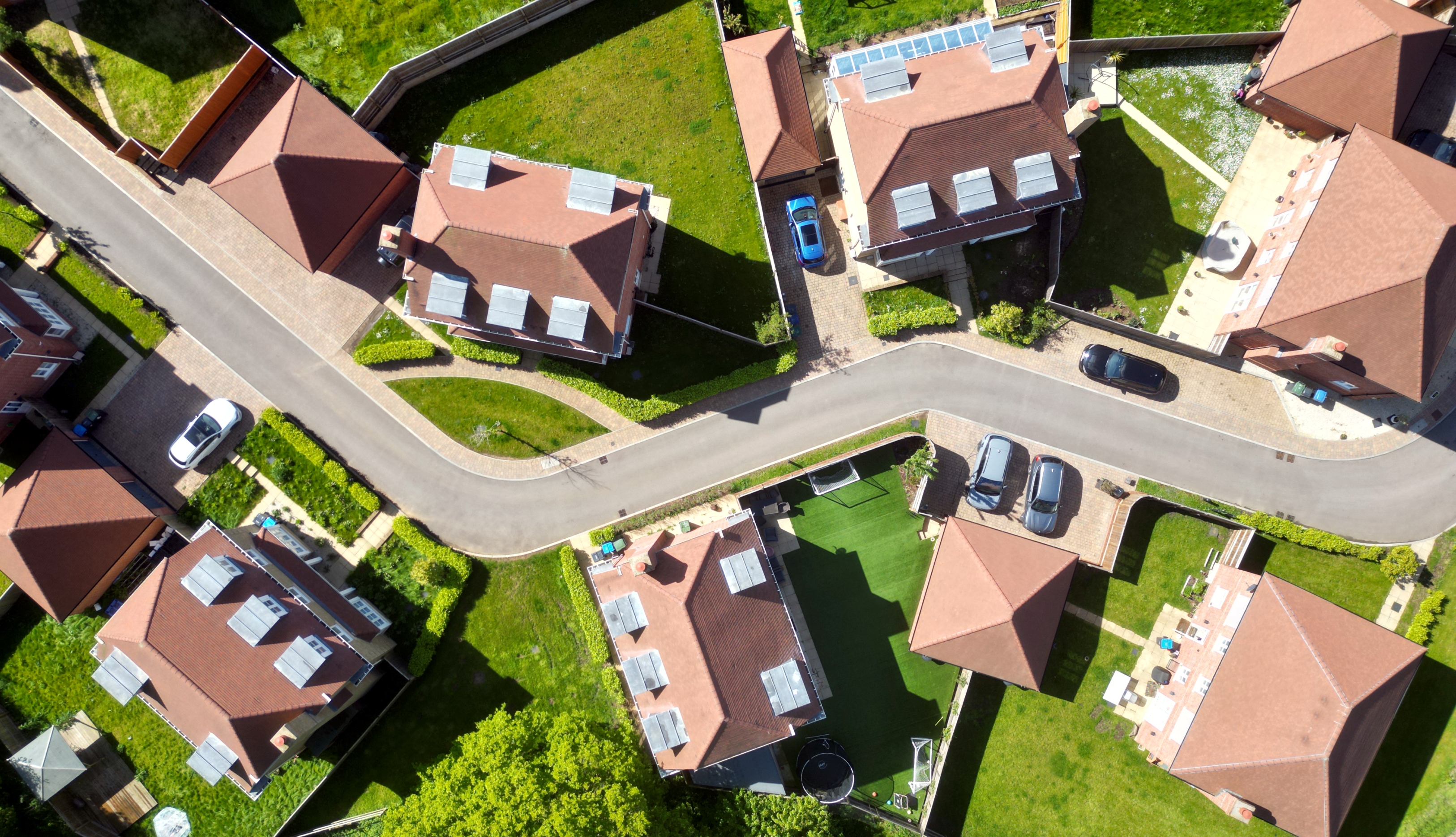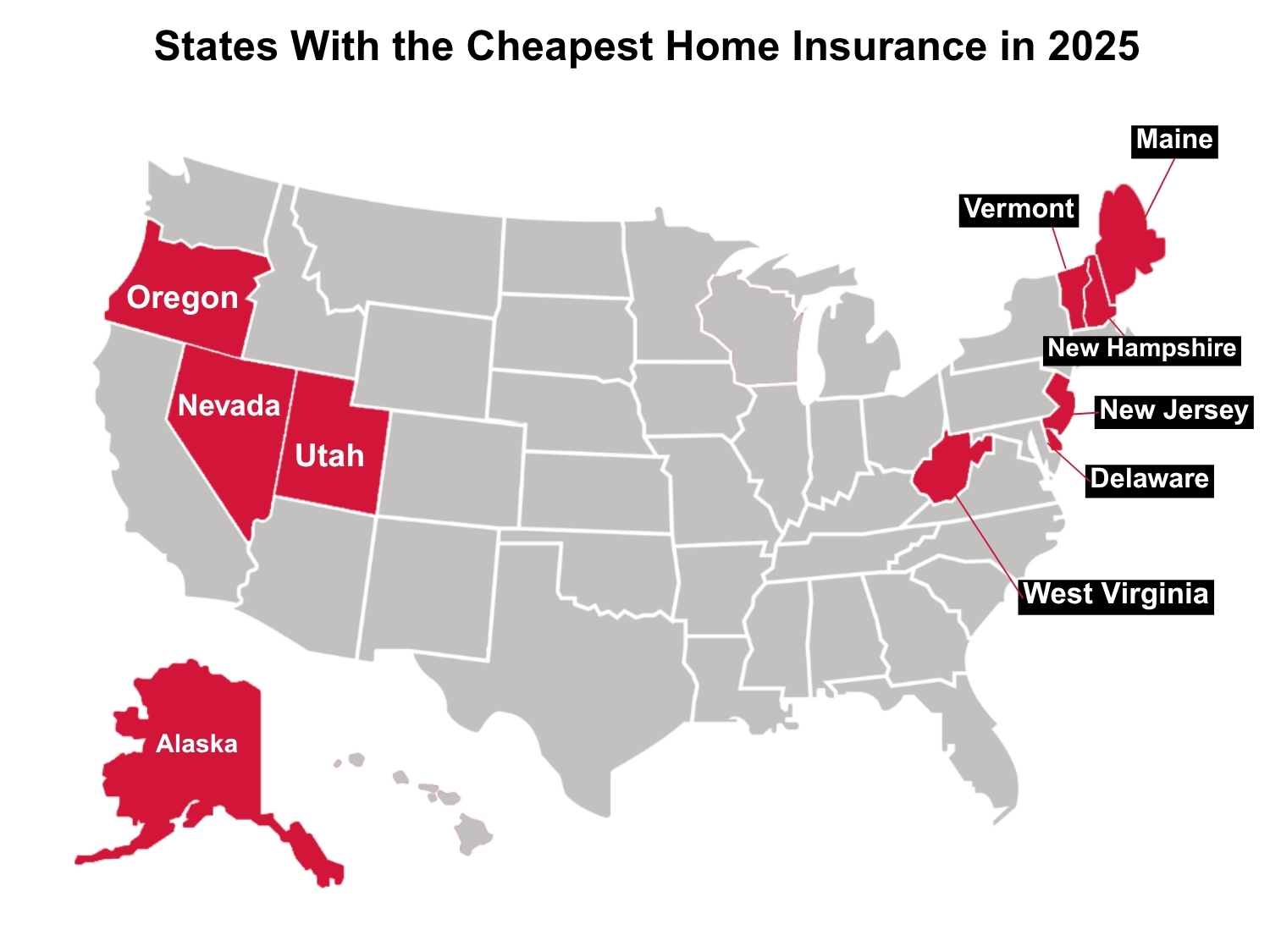10 States with the Cheapest Home Insurance in 2025
Homeowners in these 10 states pay at least $1,100 less than the national average for home insurance.


While home insurance rates are soaring after the wildfires in California and hurricanes in Florida, there are a few states where homeowners are paying well below average premiums to protect their homes.
According to the latest report from Bankrate, the national average home insurance premium in July was $2,408 per year for dwelling coverage of $300,000. But each state listed below pay rates that are at least $1,100 lower than that national average for the same coverage.
While the 10 states below are enjoying the lowest average home insurance rates in the country, it’s worth noting that this only applies to standard policies.
From just $107.88 $24.99 for Kiplinger Personal Finance
Become a smarter, better informed investor. Subscribe from just $107.88 $24.99, plus get up to 4 Special Issues

Sign up for Kiplinger’s Free Newsletters
Profit and prosper with the best of expert advice on investing, taxes, retirement, personal finance and more - straight to your e-mail.
Profit and prosper with the best of expert advice - straight to your e-mail.
Standard insurance is important, but there are a few surprising things home insurance won’t cover. For those uncovered risks, homeowners need to buy additional coverage to make sure they’re fully covered against every threat their home faces.
10 States with the Cheapest Home Insurance in 2025
Here are the 10 cheapest states for home insurance and some of the reasons why.

10. Utah
The tenth cheapest state for home insurance is Utah, with premiums averaging just $1,283 per year for $300,000 in dwelling coverage. And rates are relatively stable across the state, with residents in bigger cities like Salt Lake and Provo paying about the same as the statewide average.
There are a few reasons your home insurance bill is cheaper in Utah. The landlocked state is relatively safe from some of the most expensive threats like hurricanes, wildfires and other severe storms. It's low cost of living also means repair are cheaper when they are needed.
Still, Utah homeowners do have to brace for bad snowstorms and flooding is a risk in the southern half of the state.
9. Maine
At $1,218 per year, the average premium in Maine is well below the national average, but it is on the high side compared to its neighbors. You'll find even cheaper home insurance in New Hampshire and Vermont, for example.
One possible reason for this is that Maine is so heavily forested in much of the state, posing a higher wildfire risk than its neighbors face. It also makes home repairs a bit more expensive than average since many of the towns are fairly remote.
8. New Jersey
In New Jersey, homeowners pay $1,206 per year on average for a standard home insurance policy. While that is far below the national average, it’s important to note that most standard policies don’t cover flood damage.
Since more than half of the state’s total population lives on the coast, New Jersey is at high risk of flooding. It’s therefore essential for homeowners in the state to buy flood insurance to fully protect their homes. Even those living further inland can still be exposed to stormwater surges and other forms of flooding.
7. Oregon
Oregon homeowners saw average annual home insurance premiums of just $1,083 this year. While it’s one of the safer states to live in, the risk of wildfires has been increasing.
That risk isn’t as high as it is in California, its neighbor to the south, so Oregon hasn’t had to deal with the same issue of major insurers leaving the state.
Still, homeowners – especially those closest to the southern border – may want to take steps now to make their homes more fire ready.
Those on the west coast of the state might also want to consider buying earthquake insurance. Earthquake damage is usually excluded from standard policies and homeowners in the west have an above average risk of experiencing one.
6. Nevada
With little risk of hurricanes or other severe storms, Nevada homeowners pay just $1,074 per year on average for home insurance. The biggest weather-related issue in the state is the extreme heat it faces in the summer.
While heat is unlikely to cause any sudden damage the way storms or tornadoes do, the chronic exposure of your home to extreme heat can cause faster than usual wear and tear to things like your roof, siding and foundation. If you don’t stay on top of it, your insurer might deny your claim, citing neglect or lack of maintenance.
5. West Virginia
The average annual home insurance premium in West Virginia is just $1,048, with some areas paying less than $1,000 per year for a standard policy. However, that price doesn’t include flood insurance.
Most of the state has an above average risk of flooding, especially during hurricane season. Since flooding is typically excluded from standard home insurance policies, it’s important to buy additional coverage for flood damage.
4. New Hampshire
In New Hampshire, you can expect to pay an average of $1,040 per year for standard home insurance. The state is one of the safest places to live, as far as natural disasters go. Like other northern states, the biggest risks homeowners face are related to the snow and freezing damages experienced during New Hampshire’s harsh winters.
If you live here, make sure your pipes are insulated and you can provide proof that you’ve kept up with proper cold weather prep in your home to make your insurance claim process smoother.
3. Delaware
The small coastal state of Delaware pays an average annual home insurance premium of just $966. But like many states on the East Coast, the entire state is at high risk of flooding. So, homeowners here should use some of the savings on their regular insurance to purchase additional flood insurance.
2. Alaska
Homeowners in Alaska are paying an average of $957 per year for home insurance. As you can imagine, the biggest threats to homes in this state are related to the extreme and prolonged winter weather.
Winter-related damage is typically covered by standard home insurance, but it’s still the homeowner’s responsibility to take reasonable precautions to prevent damage.
1. Vermont
Coming in first place for the cheapest home insurance in the United States is Vermont. Homeowners in the northeastern state pay just $816 per year on average. That’s $1,592 less than the national average.
The low rates are because Vermont is one of the safest states in the country. Though some parts are at high risk of flooding. So, if you live here, doublecheck the FEMA Flood Map to find out if you’re in one of those high risk zones.
The bottom line
Insurance can be a financial lifesaver when disaster strikes. But until then, ever-increasing premiums can feel like a financial drain. That’s why it’s important to re-shop for home insurance regularly, whether you live in one of these states with cheaper than average home insurance or not.
When you do, compare both price and coverage to make sure you’re getting what you need at the best price. Don’t forget to factor in additional coverage like flood insurance or earthquake insurance, depending on which excluded risks are most prevalent in your area.
Get more insurance tips and other personal finance insights straight to your inbox. Subscribe to our daily newsletter, A Step Ahead.
Related content
Profit and prosper with the best of Kiplinger's advice on investing, taxes, retirement, personal finance and much more. Delivered daily. Enter your email in the box and click Sign Me Up.

Rachael Green is a personal finance eCommerce writer specializing in insurance, travel, and credit cards. Before joining Kiplinger in 2025, she wrote blogs and whitepapers for financial advisors and reported on everything from the latest business news and investing trends to the best shopping deals. Her bylines have appeared in Benzinga, CBS News, Travel + Leisure, Bustle, and numerous other publications. A former digital nomad, Rachael lived in Lund, Vienna, and New York before settling down in Atlanta. She’s eager to share her tips for finding the best travel deals and navigating the logistics of managing money while living abroad. When she’s not researching the latest insurance trends or sharing the best credit card reward hacks, Rachael can be found traveling or working in her garden.
-
 4 Great Tools to DIY Your Own Financial Plan
4 Great Tools to DIY Your Own Financial PlanSmart Savings Several tools picked out by Kiplinger that DIYers can use to make their own financial plan.
-
 The 7-Month Deadline That Sets Your Lifetime Medicare Premiums
The 7-Month Deadline That Sets Your Lifetime Medicare PremiumsUnderstanding Medicare enrollment is crucial, as missing deadlines can lead to permanent late enrollment penalties and gaps in coverage.
-
 Retirees Living in Portugal: You Need a Post-NHR Tax Strategy
Retirees Living in Portugal: You Need a Post-NHR Tax StrategyWhen your 10-year Non-Habitual Resident tax break ends, you could see your tax rate soar. Take steps to plan for this change well before the NHR window closes.
-
 4 Great Tools to DIY Your Own Financial Plan
4 Great Tools to DIY Your Own Financial PlanSmart Savings Several tools picked out by Kiplinger that DIYers can use to make their own financial plan.
-
 The 7-Month Deadline That Determines Your Lifetime Medicare Premiums
The 7-Month Deadline That Determines Your Lifetime Medicare PremiumsUnderstanding Medicare enrollment is crucial, as missing deadlines can lead to permanent late enrollment penalties and gaps in coverage.
-
 Should You Renew Your CD?
Should You Renew Your CD?With rate cuts impacting earnings, we examine if now is a wise time to renew CDs.
-
 Where to Store Your Cash in 2026
Where to Store Your Cash in 2026Set yourself up for success with these strategies.
-
 I'm a Financial Adviser: The Fed's Rate Cuts Could Have Impacts You Might Not Anticipate
I'm a Financial Adviser: The Fed's Rate Cuts Could Have Impacts You Might Not AnticipateUnderstanding how lower interest rates could impact your wallet can help you determine the right financial moves to make.
-
 My Teen Crashed His Car, and Now Our Insurance Has Tripled. What Now?
My Teen Crashed His Car, and Now Our Insurance Has Tripled. What Now?Dealing with the costly aftermath of a teen car accident is stressful. Here are your options for navigating it.
-
 My First $1 Million: Retired In-House Corporate Lawyer, 74, Midwest
My First $1 Million: Retired In-House Corporate Lawyer, 74, MidwestEver wonder how someone who's made a million dollars or more did it? Kiplinger's My First $1 Million series uncovers the answers.
-
 I'm an Insurance Pro: Going Without Life Insurance Is Like Driving Without a Seat Belt Because You Don't Plan to Crash
I'm an Insurance Pro: Going Without Life Insurance Is Like Driving Without a Seat Belt Because You Don't Plan to CrashLife insurance is that boring-but-crucial thing you really need to get now so that your family doesn't have to launch a GoFundMe when you're gone.